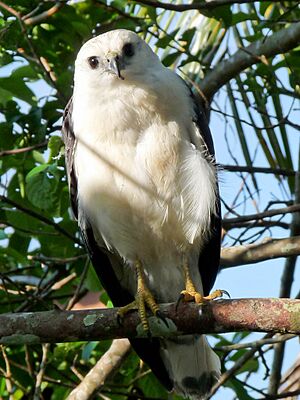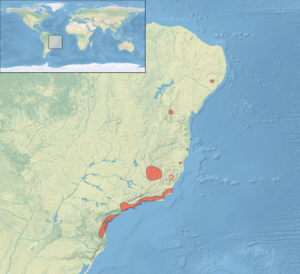White-necked hawk facts for kids
The white-necked hawk (Buteogallus lacernulatus) is a special type of bird of prey that lives only in Brazil. It's a "true hawk" from the Accipitridae family. This bird is currently a Vulnerable species, meaning it needs our help to survive.
Quick facts for kids White-necked hawk |
|
|---|---|
 |
|
| White-necked hawk at Southeast Brazil | |
| Conservation status | |
| Scientific classification | |
| Genus: |
Buteogallus
|
| Species: |
lacernulatus
|
 |
|
| Synonyms | |
|
Leucopternis lacernulata (lapsus) |
|
Contents
How Scientists Classify the White-necked Hawk
Scientists group animals into families and types. For a while, the white-necked hawk was in a group called Leucopternis. But after looking closely at its DNA, scientists decided it actually belongs in the Buteogallus group. This hawk is the only species in its specific group, meaning it's unique!
What the White-necked Hawk Looks Like
The white-necked hawk is about 43 to 48 cm (17 to 19 in) long. Its wings can spread out from 91 to 101 cm (36 to 40 in) wide. Both male and female hawks look alike, but females are a little bit bigger.
Adult hawks have a white head and white feathers on their belly. Their back feathers are black. Their tail is black with a wide white stripe in the middle. They have brown or pale yellow eyes, and their legs and feet are yellow.
Young white-necked hawks look similar to adults. However, they have dark streaks on their head and neck. Some feathers on their back might have brown tips. Their tail also has white stripes near its base.
Where White-necked Hawks Live and Their Home
You can find the white-necked hawk in parts of southeastern Brazil. They live from the state of Paraíba down to Paraná. They might have lived further south in Santa Catarina in the past.
These hawks mostly live in thick, old primary Atlantic Forest. Sometimes, they are seen in forests that have grown back after being cut down. They usually live from sea level up to at least 900 m (3,000 ft) high. In some areas, like Minas Gerais, they can be found as high as 1,300 m (4,300 ft).
White-necked Hawk Behavior
How White-necked Hawks Move Around
White-necked hawks usually stay in one area. They don't migrate far. However, there's some evidence that they might sometimes wander or move away from their usual homes.
What White-necked Hawks Eat
The white-necked hawk catches its food on the ground. It drops down from a perch, which can be as low as 1.5 m (4.9 ft) high. These clever birds are known to follow army ants and groups of monkeys. They do this to catch small animals that the ants or monkeys scare out of hiding.
Scientists are still learning exactly what these hawks eat. Some think they mostly eat arthropods, which are insects and spiders. Others believe they eat a wider variety of food. This could include arthropods, reptiles, amphibians, small mammals, other birds, and even snails.
White-necked Hawk Reproduction and Life Cycle
Right now, scientists don't know much about how white-necked hawks breed. We don't have information about their nests, eggs, or how they raise their young.
White-necked Hawk Sounds
As of late 2022, there were only a few recordings of white-necked hawk sounds. Scientists haven't yet written down what their calls sound like.
Protecting the White-necked Hawk
The IUCN (International Union for Conservation of Nature) first listed the white-necked hawk as "Threatened." Since 1994, it has been listed as "Vulnerable." This means it's at high risk of becoming endangered if we don't protect it.
The hawk's home range is small and broken up into pieces. Scientists estimate there are only between 2,500 and 10,000 adult hawks left. This number is believed to be shrinking. Their Atlantic Forest home has been greatly reduced in size. Forests are still being cut down to make room for farms.
Sometimes, people also harm these hawks. They mistakenly believe the hawks hunt farm animals. The good news is that white-necked hawks live in at least 10 protected areas. However, these areas are far apart, with deforested land in between them. Protecting more of their forest home is very important for their future.


